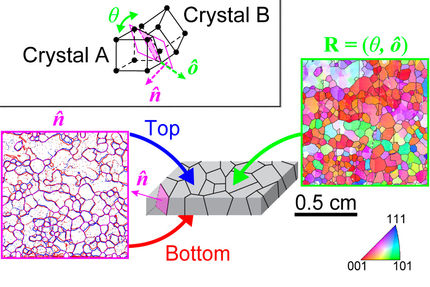New imaging technique reveals the atomic structure of nanocrystals
Advertisement
A new imaging technique developed by researchers at the University of Illinois overcomes the limit of diffraction and can reveal the atomic structure of a single nanocrystal with a resolution of less than one angstrom.
Optical and electronic properties of small assemblages of atoms called quantum dots depend upon their electronic structure – not just what's on the surface, but also what's inside. While scientists can calculate the electronic structure, they need to know where the atoms are positioned in order to do so accurately. Getting this information, however, has proved to be a challenge for nanocrystals like quantum dots. Mapping out the positions of atoms requires clues provided by the diffraction pattern. But quantum dots are so small, the clues provided by diffraction alone are not enough.
By combining two sources of information – images and diffraction patterns taken with the same electron microscope – researchers at the U. of I. can achieve sub-angstrom resolution of structures that were not possible before.
"We show that for cadmium-sulfide nanocrystals, the improved image resolution allows a determination of their atomic structures," said Jian-Min (Jim) Zuo, a professor of materials science and engineering at the U. of I.
Images from electron microscopy can resolve individual atoms in a nanocrystal, but the atoms soon suffer radiation damage, which limits the length of observations. Patterns from X-ray diffraction can be used to determine the structure of large crystals, but not for nanocrystals, which are too small and don't diffract well.
To achieve sub-angstrom resolution, Zuo and colleagues developed a reiterative algorithm that processes and combines shape information from the low-resolution image and structure information from the high-resolution diffraction pattern. Both the image and the diffraction pattern are taken with the same transmission-electron microscope.
"The low-resolution image provides the starting point by supplying missing information in the central beam and supplying essential marks for aligning the diffraction pattern," said Zuo, who also is a researcher at the university's Frederick Seitz Materials Research Laboratory. "Our phase-retrieval algorithm then reconstructs the image."
Other news from the department science

Get the chemical industry in your inbox
By submitting this form you agree that LUMITOS AG will send you the newsletter(s) selected above by email. Your data will not be passed on to third parties. Your data will be stored and processed in accordance with our data protection regulations. LUMITOS may contact you by email for the purpose of advertising or market and opinion surveys. You can revoke your consent at any time without giving reasons to LUMITOS AG, Ernst-Augustin-Str. 2, 12489 Berlin, Germany or by e-mail at revoke@lumitos.com with effect for the future. In addition, each email contains a link to unsubscribe from the corresponding newsletter.






















































